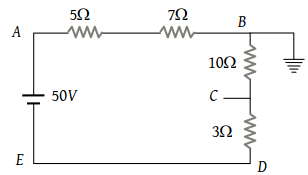The equivalent resistance of the following infinite network of resistances is

1. Less than 4 Ω
2. 4 Ω
3. More than 4 Ω but less than 12 Ω
4. 12 Ω

In the figure given below, the current passing through 6 Ω resistor is
1. 0.40 ampere
2. 0.48 ampere
3. 0.72 ampere
4. 0.80 ampere
The equivalent resistance between points A and B of an infinite network of resistances each of 1 Ω connected as shown, is
1. Infinite
2. 2 Ω
3.
4. Zero
In the circuit shown, the point ‘B’ is earthed. The potential at the point ‘A’ is :
1. 14 V
2. 24 V
3. 26 V
4. 50 V
In the circuit shown below, the cell has an e.m.f. of 10 V and internal resistance of 1 ohm. The other resistances are shown in the figure. The potential difference is :
1. 6 V
2. 4 V
3. 2 V
4. –2 V
A wire of resistance R is cut into ‘n’ equal parts. These parts are then connected in parallel. The equivalent resistance of the combination will be :
1. nR
2.
3.
4.
The current in the given circuit is
1. 8.31 A
2. 6.82 A
3. 4.92 A
4. 2 A
What is the current (i) in the circuit as shown in figure
1. 2 A
2. 1.2 A
3. 1 A
4. 0.5 A
n equal resistors are first connected in series and then connected in parallel. What is the ratio of the maximum to the minimum resistance
1. n
2.
3. n2
4.
In the figure, current through the 3 Ω resistor is 0.8 ampere, then potential drop through 4 Ω resistor is
1. 9.6 V
2. 2.6 V
3. 4.8 V
4. 1.2 V













